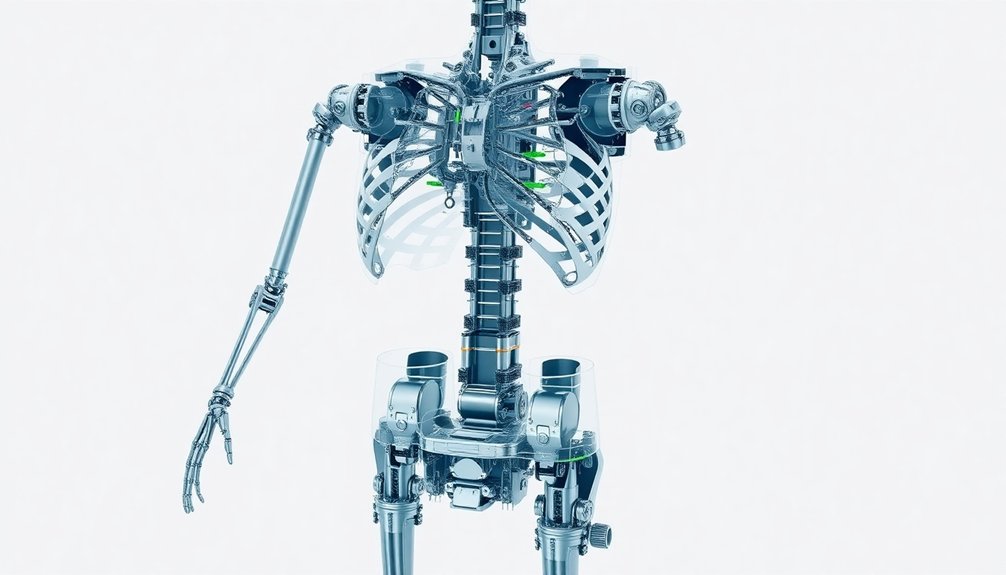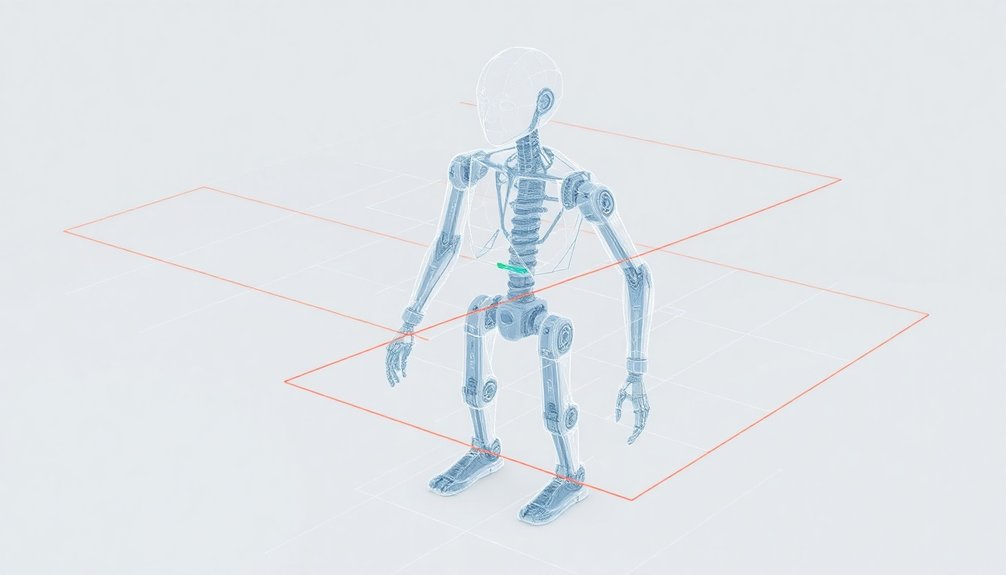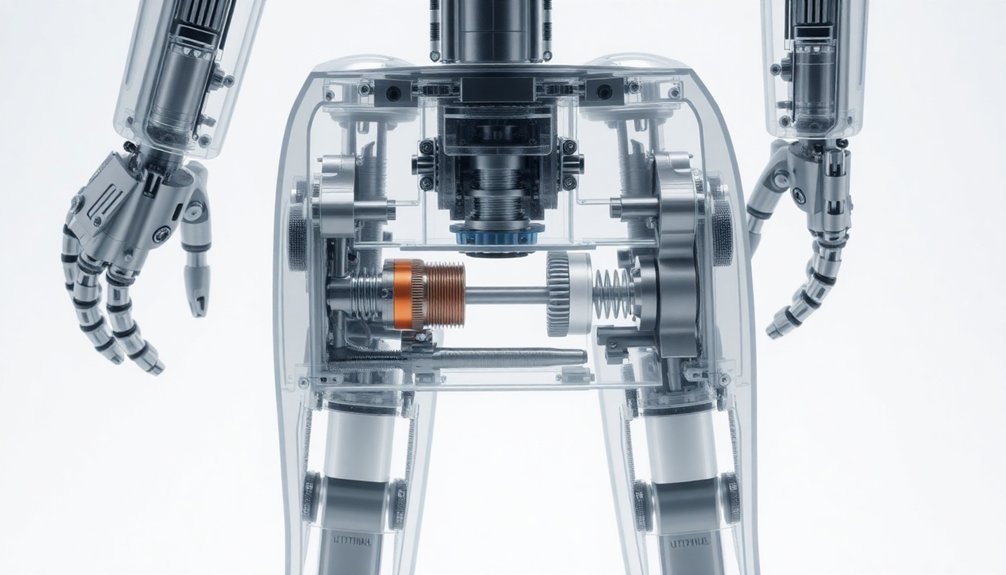Physics is the secret sauce turning robots from clunky machines into graceful mechanical beings. You’re basically designing a symphony of forces, where joints act like precision dancers and energy transfers like liquid electricity. Center of mass, mechanical impedance, and biomechanical load distribution aren’t just fancy terms—they’re the hidden blueprint that transforms metal and circuits into something almost alive. Curious about the magic behind the curtain?
Biomechanical Load Distribution and Structural Dynamics

While designing humanoid robots might sound like sci-fi fantasy, the physics behind biomechanical load distribution is dead serious engineering.
You’ll need to understand how forces flow through mechanical systems like they’re liquid electricity. Think about it: your robot’s joints are basically complex puzzles where every movement requires precise force transmission and careful load management.
The secret sauce? Matching human-like motion through smart actuator design and killer joint configurations. Electromechanical actuators enable precise robotic movement by converting electrical signals into mechanical actions.
Calf muscles can handle crazy pressure (217 ± 98 N/cm² dynamic), but your robot’s limbs need surgical precision to mimic those capabilities.
It’s not just about building a machine—it’s about creating a mechanical being that moves like a human, handles unexpected terrain, and doesn’t snap under pressure.
Physics turns sci-fi dreams into walking, talking reality. These design considerations become critical when integrating human-robot collaboration safety protocols from advanced biomechanical research.
Joint Kinetics and Motion Complexity
After wrestling with how forces dance through robotic limbs, we’ve got to crack the code of joint kinetics—the mechanical choreography that turns rigid machines into something eerily alive. Proprioceptive sensor networks enhance the robot’s understanding of its own intricate joint positioning and movement dynamics. Your robot’s motion isn’t just math; it’s physics playing puppet master. Joint configuration complexity emerges from the fundamental interplay between mechanical design and movement potential.
| Joint Type | Motion Range | Complexity |
|---|---|---|
| Rolling | High | Moderate |
| Sliding | Limited | Low |
| Rotational | Moderate | High |
| Spherical | Expansive | Very High |
Each joint tells a story of constraint and possibility. Imagine your robot’s knee—not just a hinge, but a sophisticated mechanism translating human-like movement through calculated compromises. Rolling contact mechanisms let limbs fold and unfold with surprising grace, while tensioners whisper subtle corrections. You’re not just building a machine; you’re sculpting motion itself, where every degree of freedom represents a potential dance between mechanical precision and biological inspiration.
Center of Mass Optimization Strategies

When you’re building a humanoid robot that won’t embarrass itself by toppling over like a drunk toddler, Center of Mass (CoM) optimization becomes your holy grail. Robot state estimators like Ken Masuya’s research suggest precise motion control is critical for advanced robotic performance. Sensor fusion techniques enable robots to continuously adapt their balance strategies by integrating multiple sensory inputs for more nuanced movement prediction.
You’ve got three killer strategies to keep your robot upright and elegant:
- Use Zero-Moment Point tracking to predict and prevent balance failures before they happen.
- Implement multicontact dynamics models that translate complex environmental interactions into smooth, predictable movements.
- Optimize foot placement trajectories to maximize stability without looking like a stiff mechanical nightmare.
Your goal? Make robots move like they’ve got an internal gyroscope of pure physics magic.
Energy Transfer and Momentum Control
Once you’ve mastered keeping your robot from face-planting, the next physics magic trick is making it move like it’s got rocket-powered ballet shoes. Mechanical system dynamics are critical in translating theoretical models into robotic performance. Neuromorphic computing allows engineers to translate complex physical principles into adaptive robotic movement. Energy transfer isn’t just science—it’s robotic choreography. Your humanoid needs to dance between kinetic and potential energy like a quantum parkour expert.
| Energy Source | Transfer Mechanism | Performance Impact |
|---|---|---|
| Gravitational | Spring-mass dynamics | Momentum preservation |
| Kinetic | Compliant actuators | Reduced power drain |
| Elastic | Series-parallel design | Enhanced agility |
| Potential | Impact absorption | Shock mitigation |
Clever biomimetic design turns physics constraints into superpowers. By embedding springs, dampers, and smart transmission ratios, you’ll transform clunky machinery into a momentum-conserving marvel. Want a robot that moves like liquid mercury? Master energy transfer, and watch physics do the heavy lifting.
Mechanical Impedance and Adaptive Stability

If physics is the secret sauce of robotics, mechanical impedance is the magic spice that turns clunky machines into responsive dance partners. Advanced control algorithms enable robots to dynamically map complex interaction dynamics with unprecedented precision.
It’s how robots go from robotic zombies to smooth collaborators. Think of impedance control as the robot’s emotional intelligence, letting machines:
- Sense and adapt to external forces in real-time
- Modulate stiffness like a yoga instructor adjusting flexibility
- Prevent catastrophic collisions by absorbing unexpected impacts
Imagine a robot lifting a delicate vase or working alongside a human without crushing bones. Biohybrid muscle integration allows robots to develop more nuanced and responsive movement capabilities.
Robotic grace: handling fragile objects and human collaboration with surgical precision and gentleness.
That’s not sci-fi magic—it’s precise physics. By dynamically tuning force responses, robots transform from rigid automatons into fluid, intuitive partners.
They’re learning to feel, not just move. The result? Machines that don’t just compute, but genuinely interact—turning cold algorithms into something surprisingly… human.
People Also Ask About Robots
How Do Humanoid Robots Actually Balance Without Falling Over Constantly?
You’ll maintain balance by dynamically tracking your zero moment point, constantly adjusting joint torques, and shifting your center of mass within your base of support—just like a human carefully maneuvering unstable terrain.
Can Robots Really Mimic Human Movements With Precise Mechanical Accuracy?
You’ll be amazed how robots can mirror human motion! Advanced kinematic structures and adaptive control systems precisely replicate joint mechanics, using redundant sensors and high-speed actuators to translate complex movements with remarkable mechanical accuracy.
What Prevents Robotic Joints From Breaking During Sudden Unexpected Impacts?
You’ll prevent robotic joint failure through intelligent design: using elastic elements, real-time force sensors, compliant materials, and dynamic feedback systems that absorb shock, redistribute loads, and instantly adjust to unexpected impacts.
How Much Human-Like Flexibility Can Mechanical Systems Realistically Achieve?
Like a stiff dancer constrained by rigid choreography, you’ll find mechanical systems can achieve roughly 60-70% of human joint flexibility. Advanced tendon-driven designs and smart materials are pushing boundaries, but fundamental physical limitations persist.
Why Don’t Humanoid Robots Topple When Performing Complex Dynamic Movements?
You won’t topple because advanced robotic systems use multi-joint coordination, real-time sensory feedback, and predictive control algorithms that constantly adjust your center of pressure and angular momentum during dynamic movements.
Why This Matters in Robotics
Physics isn’t just fancy math—it’s the secret sauce making robots walk without face-planting. You’ll want to pay attention: these mechanical marvels aren’t sci-fi fantasies anymore, but precision-engineered dance partners of engineering and natural laws. Think of humanoid robots like sophisticated puppets, where every joint, momentum transfer, and balance calculation determines whether they strut or stumble. The future? It’s not about building robots, but choreographing their impossible movements.
References
- https://www.wevolver.com/article/design-considerations-for-humanoid-robots
- https://www.science.org/doi/10.1126/scirobotics.aaq0899
- https://www.servomagazine.com/magazine/article/humanoid-robotics-design-considerations
- https://koasas.kaist.ac.kr/bitstream/10203/3025/1/Development of Humanoid Robot Design Process.pdf
- https://dspace.mit.edu/bitstream/handle/1721.1/153618/2104.09025.pdf?sequence=2&isAllowed=y
- https://www.mdpi.com/2076-3417/13/3/1957
- https://www.tandfonline.com/doi/full/10.1080/01691864.2020.1813624
- https://www.vaia.com/en-us/explanations/engineering/robotics-engineering/biomechanics-in-robotics/
- https://www.frontiersin.org/journals/robotics-and-ai/articles/10.3389/frobt.2021.667818/pdf
- https://waseda.elsevierpure.com/en/publications/mechanics-of-humanoid-robot
